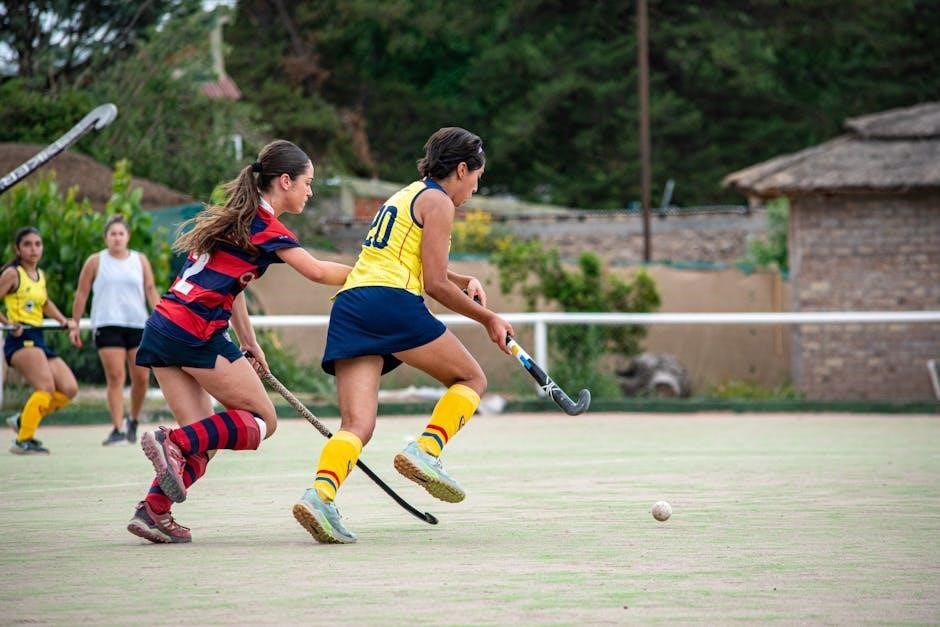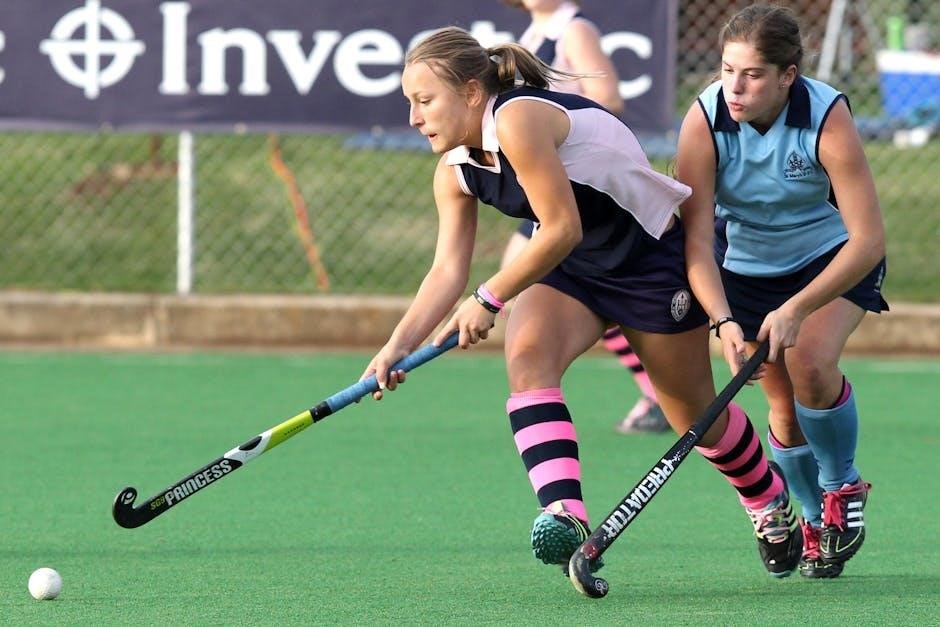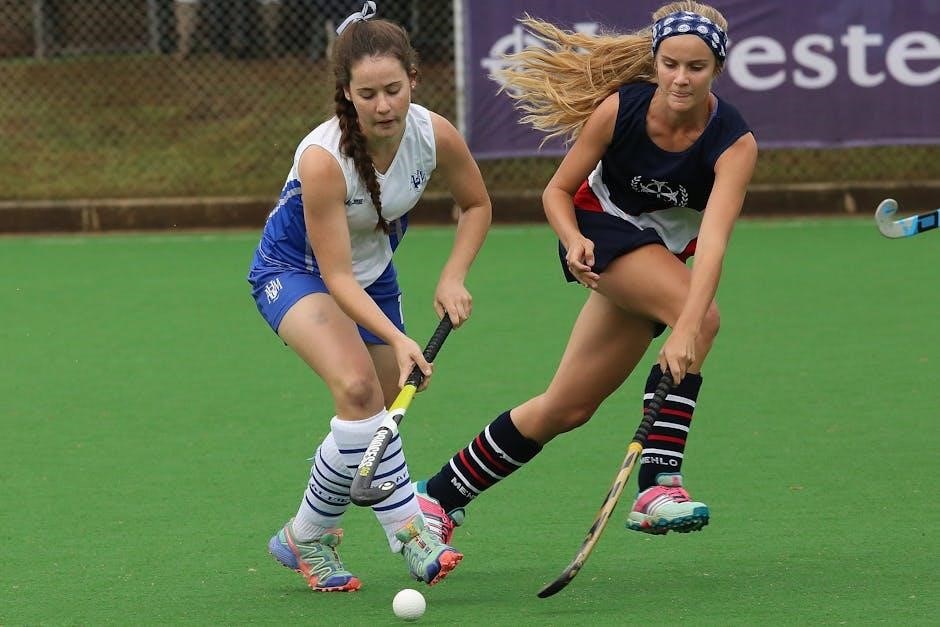Choosing the right field hockey stick size is crucial for performance and comfort. This guide helps players select the ideal stick based on height, position, and skill level, ensuring optimal gameplay and personal preference alignment.
Why Stick Size Matters in Field Hockey
Stick size is critical in field hockey as it directly impacts performance, comfort, and control. A properly sized stick ensures optimal ball control, precise passing, and powerful shooting. If a stick is too long, it can be cumbersome, reducing maneuverability and accuracy. Conversely, a stick that’s too short may limit reach and power. The right size enhances a player’s ability to handle the ball effectively, especially during dynamic plays. Additionally, proper sizing contributes to better posture and reduces the risk of injury. Players in different positions, such as forwards or defenders, may prefer varying stick lengths to suit their roles. Ultimately, the correct stick size is essential for maximizing skill execution and overall gameplay efficiency.
Key Factors Influencing Stick Size Selection
Several factors influence the selection of the ideal field hockey stick size. Player height is a primary consideration, as it determines the stick’s length. Personal preference also plays a significant role, with some players favoring longer sticks for reach and others opting for shorter sticks for better control. Position on the field is another crucial factor; forwards often prefer shorter sticks for agility, while defenders and midfielders may choose longer sticks for better reach and power. Skill level is also important, as younger or less experienced players may benefit from lighter, more manageable sticks. Additionally, stick weight and balance should be considered to ensure comfort and performance. These factors collectively guide the selection process to ensure the stick aligns with the player’s needs and enhances their gameplay.


Understanding Field Hockey Stick Measurements
Stick length is crucial, measured from the stick’s head to the end of the handle. It’s typically determined by player height and personal preference, ranging from 28 to 37.5 inches, ensuring optimal performance and comfort.
Standard Length Ranges for Field Hockey Sticks
Field hockey sticks typically range in length from 28 to 37.5 inches, catering to players of all ages and skill levels. Youth players often use sticks between 28 and 32 inches, while adult players prefer lengths from 36 to 37.5 inches. The length is designed to balance reach and maneuverability, ensuring optimal performance. Taller players generally opt for longer sticks, while shorter players prefer shorter ones for better control. Personal preference and skill level also influence the choice, as some players may favor a slightly shorter or longer stick for comfort and effectiveness. Proper fit is essential to maximize performance and comfort during gameplay.
Weight and Balance of the Stick
The weight and balance of a field hockey stick play a significant role in performance. Sticks typically weigh between 535 grams and 750 grams, with lighter sticks offering better control and agility. Balance is crucial, as it determines how the stick feels during gameplay. The balance point, usually around the head or handle, affects handling and striking power. Forwards often prefer lighter sticks for quick maneuvers, while defenders may opt for slightly heavier sticks for added power. The composition of materials, such as carbon, fiberglass, and aramid, influences both weight and durability. A well-balanced stick enhances precision, control, and overall gameplay efficiency, making it a key factor in player preference and performance.
Importance of Bow Size and Shape
The bow of a field hockey stick, the curved part at the head, plays a crucial role in gameplay. Its size and shape affect ball control, striking power, and drag flicking. Standard bows range from 20mm to 25mm, with larger bows offering better control but less precision. Smaller bows provide quicker ball movement and are preferred by forwards and midfielders. The shape, whether it’s a classic ‘J’ shape or a more modern design, impacts how the stick handles the ball. Goalkeepers often use sticks with larger bows for better clearances. The bow’s size and shape must comply with regulations, ensuring fair play. Players should choose a bow that matches their skill level and playing style for optimal performance.

How to Choose the Right Stick Size
Stick size depends on height, skill level, and position. The top of the stick should reach the hip bone when upright, balancing comfort and performance effectively.
Height Chart for Selecting Stick Length
A height chart is the most common method for selecting a field hockey stick. The stick length generally corresponds to the player’s height, ensuring comfort and optimal performance. For example, players under 3 feet tall typically use a 24-inch stick, while those between 3’5″ and 4’10” often prefer a 28-30 inch stick. Taller players, above 4’10”, usually opt for 32 inches or longer. The stick should reach approximately 2 inches below the hip bone when standing upright. This chart serves as a starting point, allowing players to adjust based on personal preference and playing style. Proper stick length ensures better control, dribbling, and shooting accuracy during the game.
- Under 3′ ⏤ 24 inches
- 3’5″, 4’10” ⏤ 28-30 inches
- Above 4’10” — 32 inches or longer
Measuring Stick Length for Optimal Performance
To ensure optimal performance, measuring the stick length correctly is essential. The stick should reach approximately 2 inches below the player’s hip bone when standing upright. This measurement ensures proper control and comfort. Players should stand with their skates or shoes on and hold the stick vertically to assess the length. The top of the stick should align with a point just below the hip bone for ideal balance. Proper stick length enhances dribbling, passing, and shooting accuracy. If the stick is too long, it may feel cumbersome, while a stick that’s too short can limit power and precision. Measuring accurately is the first step to selecting a stick that suits your playing style and height. This ensures peak performance on the field.
How to Measure Without a Stick
If you don’t have a stick, you can still determine the ideal length using your height. Stand with your shoes on and measure from the ground to the top of your hip bone. Subtract 2 inches from this measurement to find your optimal stick length. For example, if your hip height is 36 inches, your stick should be around 34 inches. This method ensures a comfortable and effective playing experience. Additionally, personal preference and position requirements can influence the final measurement, so slight adjustments may be needed. Always consider growth if measuring for a junior player, as sticks can be chosen with future height in mind.

Factors Influencing Stick Size
Player position, skill level, and personal preference are key factors influencing stick size. Forwards may prefer shorter sticks for control, while defenders opt for longer ones. Goalkeepers often use extra-long sticks for clearing. Beginners might choose shorter lengths for easier handling, while experienced players may prefer longer sticks. Personal comfort and gameplay style also play significant roles in selection.
Player Position and Stick Size
Stick size varies significantly based on player position in field hockey. Forwards often prefer shorter sticks for agility and ball control, while defenders and midfielders opt for slightly longer sticks to enhance reach and power. Goalkeepers typically use the longest sticks, designed for clearing and blocking shots. The position-specific requirements ensure players can perform their roles effectively. Personal preference and skill level also influence stick length, but position remains the primary determinant. Balancing stick length and weight is crucial for optimal performance across all positions. This positional customization allows players to maximize their effectiveness on the field, ensuring the right tool for their specific role.
Skill Level and Stick Size Recommendations
Skill Level and Stick Size Recommendations
Skill level significantly influences field hockey stick size recommendations. Advanced players often prefer longer sticks for increased power and reach, while less experienced players benefit from shorter sticks for better control and maneuverability. Beginners may find shorter sticks easier to handle, allowing them to develop essential skills. As players progress, they can transition to longer sticks, enhancing their performance. Ultimately, stick size should align with a player’s ability to manage both length and weight effectively. Personal preference and comfort also play a role, as confidence in the stick’s feel can greatly impact performance. Balancing stick length with skill level ensures optimal gameplay and continued development. Proper stick size fosters improved technique and overall success on the field.
Personal Preference in Stick Length
Personal preference plays a significant role in selecting the ideal stick length, as it directly impacts comfort and performance. While height charts provide a starting point, players often adjust based on their playing style and comfort. Some prefer a slightly shorter stick for better control, while others opt for a longer stick to enhance reach and power. Taller players may gravitate toward longer sticks, but this isn’t universal, as personal comfort can override standard recommendations. Ultimately, the stick should feel natural and allow for seamless movement during gameplay. Testing different lengths and listening to your body’s feedback are essential steps in finding the perfect fit. Personal preference ensures the stick becomes an extension of the player, fostering confidence and consistency on the field. Comfort and control are key to making the right choice.
Field Hockey Stick Materials and Construction
Modern sticks combine carbon, fibreglass, and aramid for durability, weight reduction, and enhanced performance, ensuring optimal balance and power during gameplay.
Impact of Materials on Stick Size
Field hockey sticks are crafted from materials like carbon, fibreglass, and aramid, which influence size, weight, and performance. Carbon enhances durability and reduces weight, allowing for longer sticks without sacrificing control. Fibreglass adds flexibility, enabling shorter sticks for precise ball handling. Aramid improves strength, maintaining stick integrity during intense gameplay. The combination of these materials ensures sticks meet size regulations while catering to positional demands. Lighter sticks, often preferred by forwards, are made possible by high carbon content, while defenders may opt for slightly heavier, more durable options. Material composition directly impacts stick size, balancing performance and player needs effectively.

Composition of Modern Field Hockey Sticks
Modern field hockey sticks are primarily made from carbon fibre, fibreglass, and aramid, with some incorporating wood for added durability. Carbon fibre is prized for its lightweight and strength, while fibreglass adds flexibility. Aramid enhances impact resistance, making sticks more robust during gameplay. The composition varies by brand and model, with high-end sticks often featuring higher carbon content for superior performance. The stick’s head is typically made from a durable material to withstand ball impact, while the handle is designed for grip and control. This blend of materials ensures sticks meet size regulations while delivering optimal performance for players of all levels.
How Construction Affects Performance
The construction of a field hockey stick significantly impacts its performance. The balance of weight and power is crucial, with lighter sticks offering faster swing speeds while heavier ones provide more hitting power. The head’s shape and size influence ball control and striking accuracy, while the handle’s design affects grip and maneuverability. High-quality materials like carbon fibre enhance energy transfer during shots, improving overall efficiency. Additionally, the stick’s flex rating determines its responsiveness during passes and dribbles. Proper construction ensures durability, minimizing the risk of breakage during intense gameplay. Players can optimize their skills by selecting a stick whose construction aligns with their playing style, position, and performance goals.

Stick Size Chart by Age and Position
Stick size varies by age and position, ensuring optimal fit and performance. Youth players use shorter sticks, while adults prefer longer lengths for better control and power.
Stick Length Recommendations for Youth Players
For youth players, stick length is determined by age, height, and personal preference. Typically, players under 3′ use a 24″ stick, while those between 3′-3’5″ opt for 26″. Heights from 3’5″-3’10” suit a 28″ stick, and 3’10”-4’2″ prefer 30″. Taller youth players (4’2″-4’6″) often choose 32″ sticks. These recommendations ensure proper handling and control, allowing young players to develop their skills effectively. Personal preference and position can also influence the choice, with forwards often favoring shorter sticks for agility and midfielders/defenders opting for slightly longer ones. Ensuring the stick is appropriately sized helps prevent discomfort and enhances performance, making it essential to consider growth when selecting a stick for junior players.
Adult Stick Length Guidelines
Adult field hockey sticks typically range from 36.5″ to 37.5″, with some players opting for 38.5″ sticks. The choice depends on height, personal preference, and playing position. Generally, the stick should reach just below the hip bone when standing upright. Forwards often prefer shorter sticks for better control, while midfielders and defenders may choose slightly longer sticks for added reach. Goalkeepers typically use longer sticks for better defense. It’s important to ensure the stick feels comfortable and allows for effective gameplay. Balancing length and weight is crucial for optimal performance. Always consider personal comfort and positional needs when selecting a stick size.
Position-Specific Stick Size Chart
Position-specific stick sizes are tailored to enhance performance based on role. Forwards often use shorter sticks (36.5″–37″) for agility and control. Midfielders prefer medium lengths (37″–37.5″) to balance speed and reach. Defenders opt for longer sticks (37.5″–38.5″) for better interception and tackling. Goalkeepers use the longest sticks (38.5″–40″) to cover more area. Stick length is chosen based on height and personal preference. Forwards and midfielders may prefer slightly shorter sticks for maneuverability, while defenders need length for reach. Each position’s stick size is designed to optimize skills and effectiveness in gameplay. Ensure the stick aligns with both positional demands and personal comfort for peak performance.

Pro Tips for Choosing the Right Stick
Always try sticks before buying, consider growth for juniors, and balance length with weight for optimal performance and comfort on the field.
Trying Before Buying
Trying a stick before purchasing is essential to ensure it feels right for you. Hold the stick to assess its weight, balance, and bow size. Test how it handles the ball, as this affects control and performance. Many players find that physically interacting with the stick provides insights that measurements alone can’t offer. If possible, use the stick in a practice session to gauge comfort and maneuverability. This step helps avoid buying a stick that looks right but doesn’t feel right during gameplay. Prioritize this step to ensure your stick enhances your skills and overall playing experience.
Considering Growth for Junior Players
When selecting a stick for junior players, it’s important to consider their growth potential. While the stick should fit their current height and skill level, purchasing a slightly longer stick can accommodate future growth. This approach prevents the need for frequent replacements as the player grows taller and develops their skills. However, avoid sticks that are excessively long, as they can be difficult to handle and may hinder performance. A balanced approach ensures the stick meets immediate needs while allowing room for growth. Regularly reassessing the stick’s fit as the player grows is key to maintaining optimal performance and comfort.
Balancing Stick Length and Weight
Balancing stick length and weight is essential for optimal performance. A longer stick may offer greater reach but can be heavier, affecting agility. Conversely, a shorter, lighter stick enhances maneuverability but reduces reach. Players must consider their position; forwards and midfielders often prefer lighter sticks for quick handling, while defenders may opt for slightly longer sticks with more weight for powerful hits. The material composition also plays a role, as carbon and composite sticks are generally lighter and stronger. Finding the right balance ensures the stick complements the player’s style without compromising performance or comfort. Proper balance enhances control, accuracy, and overall gameplay effectiveness.

Common Mistakes to Avoid
Overlooking personal preference and position-specific needs are frequent errors. Ignoring stick regulations and not testing sticks before purchase can hinder performance and lead to discomfort during play.
Overlooking Personal Preference
Many players neglect the importance of personal preference when selecting a stick, focusing solely on height charts. However, comfort and feel are critical for performance. A stick that doesn’t suit a player’s style can hinder control and confidence. For example, some prefer a lighter stick for agility, while others opt for heavier ones for power. Ignoring personal preference can lead to discomfort and reduced effectiveness on the field. It’s essential to test sticks and consider how they feel during play. Players should prioritize their own comfort and style over strict height guidelines, ensuring the stick aligns with their unique needs and playing approach.
Ignoring Position-Specific Requirements
One common mistake is ignoring how a player’s position influences stick size. Forwards often prefer shorter sticks for better ball control and agility, while defenders may opt for longer sticks to intercept passes and maintain reach. Midfielders typically require a balanced stick length for versatility. Goalkeepers, conversely, need shorter sticks for easier maneuverability. Failing to consider these positional needs can lead to reduced performance and discomfort. Players should align their stick choice with their specific role on the field to maximize effectiveness and ensure optimal gameplay. Ignoring position-specific requirements can hinder a player’s ability to execute skills efficiently and comfortably.
Not Checking Stick Regulations
Overlooking stick regulations is a critical error that can lead to disqualification or penalties during a match. Field hockey sticks must meet specific standards set by governing bodies like the International Hockey Federation (FIH). These regulations ensure fair play and safety. Players often neglect to verify that their stick’s length, weight, and material composition comply with official rules. Additionally, the stick’s bow size and shape are subject to strict guidelines, as excessive curvature can be deemed illegal. Officials regularly inspect sticks before games, and non-compliant equipment can result in penalties or exclusion from play. Always check the latest regulations before competitions to avoid such issues and ensure your stick meets all necessary standards for legal use. This step is vital for maintaining fairness and safety in the sport.
Selecting the right field hockey stick size is vital for optimal performance and comfort. Consider height, position, skill level, and regulations to find your ideal stick and elevate your game.
Final Thoughts on Stick Size Selection
Choosing the right field hockey stick size is a balance of height, position, skill level, and personal comfort. While height charts provide a starting point, players should consider their role on the field, with forwards often preferring shorter sticks for control and defenders opting for longer ones for reach. Skill level also plays a role, as more experienced players may prefer lighter or stiffer sticks. Ultimately, the stick should feel natural and allow for precise ball control. Testing different sizes and styles is essential to find the perfect fit. Remember, regulations vary, so ensure your stick meets governing body standards for your league or competition.
Encouragement to Test and Adjust
Testing different stick sizes and styles is crucial to finding the perfect fit. Players should not hesitate to try out various lengths and weights to ensure comfort and performance. Even after selecting a stick, adjustments may be necessary as skill levels improve or playing styles evolve. Encourage experimenting with different sticks during practice to gauge what feels most natural. Personal comfort and confidence in the stick are key to unlocking potential on the field. Remember, there’s no one-size-fits-all solution, so take the time to explore options and make adjustments as needed. This approach ensures optimal performance and enjoyment of the game.
